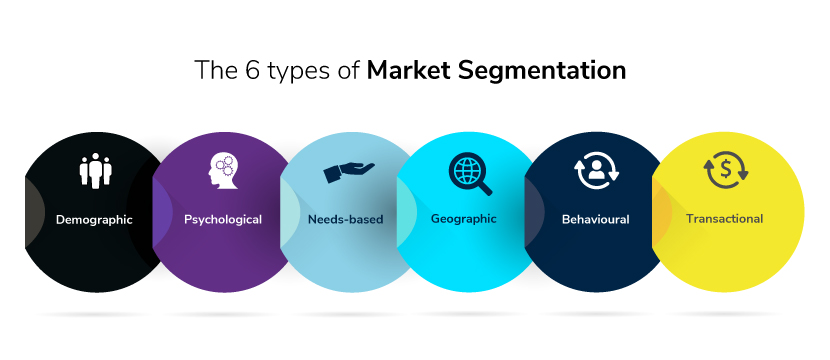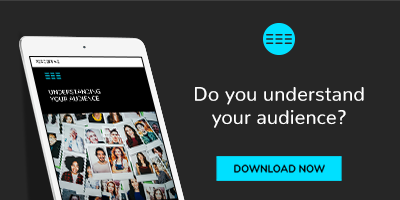Looking for a new way to segment your target audience? This is everything you need to know about the 6 types of market segmentation: demographic, geographic, psychographic, behavioural, needs-based and transactional.
 Demographic
Demographic
Demographic segmentation separates your audience by who they are. It is one of the most common segmentation types used in market research (alongside geographic). It is simple to use and understand, is readily accessible through common data gathering methods, and it can eliminate irrelevant audience segments quickly and easily.
Also note, the demographic traits you use to segment your audience may change depending on whether you are in a B2B or a B2C context.
For example, typical B2C demographic traits include:
- Age
- Gender
- Occupation
- Income
- Family status
- Education
Meanwhile, a B2B audience might include the above, as well as:
- Company size
- Industry type
- Role (within company)
- Time in position
Example
A high-end jewellery store segments their audience by high household income. This focus ensures they don’t waste valuable resources on targeting an audience that wouldn’t be interested in their products.
Meanwhile, a software-as-a-service company that sells software to research firms segments their target audience by role hierarchy. This gives them the opportunity to create marketing campaigns that resonate with relevant decision makers in their audience.
For more information on market segmentation, read our guide to understanding your audience or download a take-home copy below.
Geographic
Geographic segmentation splits your audience depending on where they are located.
For example:
- Continent
- Country
- Region
- City
- Borough/District
Segmenting in this way is best used when a customer’s location influences their purchase decision. This is going to be true for nearly any business, which is why geographical segmentation is one of the most popular forms of segmentation used.
The fact that nearly every business will have some kind of geographical information on their customers (obtained through address submissions for newsletters, coupons, apps, in-house services, etc) also makes this one of the easiest to implement as well.
Example
A large business with international holdings segments by geography to get a clearer picture on its audience volumes in the United States versus the United Kingdom.
Discovering the popularity of the business’ products in the UK, the company decides to develop a .co.uk website address and produce content specifically for its UK audience.
Related content: 3 ways to use your market segmentation strategy to be more competitive
Psychographic
Psychographic segmentation separates your audience by their personality.
For example:
- Interests
- Attitudes
- Values
- Lifestyle
This can be especially useful for businesses which sell a product or service that will make an impact on people with specific world views or ideas.
NB: psychographic segmentations can include a lot of different factors. The above list is not exhaustive by any means; ensure that you cover as many “softer” psychological characteristics in your initial market research to ensure you don’t miss any important perspectives.
Example
A retailer segments their data by the value of “budget-consciousness”, separating those among their audience who consider themselves particularly frugal from those who are less concerned about how much they spend.
Noting a distinct dip in the number of budget-conscious customers, the research consultants suggest that the retailer may want to either develop a new line of everyday essentials, or better position their existing products to appeal to this budget-conscious group.
Related content: 5 questions to ask before targeting any customer segment
Behavioural
Behavioural segmentation divides your audience by their previous behaviour in relation to your brand.
For example:
- Awareness of the business
- Previous purchases
- Purchase patterns
- Usage level
- Product knowledge
- Product/service rating
Example
A local restaurant segments its audience data by purchase patterns, specifically when the purchase was made. This allows it to investigate its lunch-time audience compared to its dinner-time audience.
By comparing the difference in the type of meals purchased between each of these times, the restaurant is able to create a new lunch and dinner menu that better suits its individual groups of customers.
Related content: The power of claimed behaviour versus actual behaviour
Needs-based
Needs-based segmentation groups your audience by similar needs and/or benefits a particular group is seeking.
Needs-based segments have four broad categories:
- Problem-solving needs. Your product or service solves a problem for a group of your customers' experience. (For example, gluten free products for customers with celiac disease).
- Functional needs. AKA practical needs. Are customers looking for a way to make something easier, perform better, more efficient, less risky? (For example, a software developer might release a budgeting app to help customers manage their finances).
- Emotional needs. Do a group of your customers share an emotional desire or frustration? (Beauty companies, for example, create products that address specific frustrations such as wrinkles or acne).
- Value alignment. Products or services that align with personal values and/or beliefs (Halal and vegan products are good examples of this).
In many cases, a needs-based segment will fall into multiple categories, so it is important to consider each category and how it might apply to a particular segment.
Example
A food manufacturer segments its audience by those who purchase its gluten free products. This allows the company to explore how well its gluten free range solves the need for gluten-free alternatives for people with celiac disease or gluten intolerance. Surveying this segment reveals that the company’s gluten free products are meeting this segment's functional needs—i.e. dietary requirements, nutritious, tasty, easy to prepare. However, the company also discovers that customers in this segment are tired of eating the same gluten free meals that use their products. As a result, the company creates a series of new recipes to bring in more meal variety and to help this segment further enjoy the product range.
Transactional (RFM)
Transactional segmentation, or RFM modelling, looks at the spending patterns of your customers to identify who your most valuable customers are and group them by behaviour.
The model catalogues customers according to:
- Recency. How recently a customer purchased from your business.
- Frequency. How often they purchase from you.
- Monetary. How much they spent.
Example
A clothing chain wants to re-engage their loyalty card customers who haven’t visited one of their stores in the last six months. By looking at transactional data, they can first identify customers who haven’t visited in six months, and next segment them according to their RFM behaviours. For example, customers who visit often, but spend a small amount; customers who visit less frequently, but spend a lot; and customers who don’t visit often and don’t spend much either.
From here the company could create tailored promotions aimed specifically at their two most valuable segments: frequent visitors with low spend (let’s call the Segment A) and the sometimes visitors with high spend (Segment B). Segment A customers might receive a promotion relating to the retailer’s accessories and under $50 items, while Segment B might get a promotion showcasing new season arrivals or more expensive items now on sale.
Read more about RFM modelling and how it works here.
Leveraging each of these segment types is integral for getting the granular data you need to better understand and target your audience. By gathering each type and segmenting your audience with them in conjunction, you can achieve granular, specific and robust research insights.
For more information on market segmentation, download our all-in-one guide to understanding your audience.

